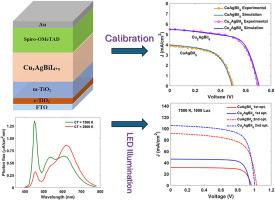LED照明下三维和二维全无机CuxAgBiI4+x太阳能电池性能的增强
IF 4.9
3区 材料科学
Q2 CHEMISTRY, MULTIDISCIPLINARY
引用次数: 0
摘要
对传统卤化铅钙钛矿材料的可持续、无铅替代品的追求导致了对铜银铋卤化物的探索。由于其稳定性、可调带隙和光吸收能力,这些材料已成为光电应用的有利候选者。本模拟研究考察了全无机宽禁带CuxAgBiI4+x太阳能电池在室内照明条件下的性能增强,特别是使用1000勒克斯和不同色温(7500 K和2900 K)的白光LED照明。基线电池具有FTO/c-TiO2/m-TiO2/CuxAgBiI4+x/Spiro-OMeTAD,首先使用器件模型进行校准,以验证SCAPS器件模拟器的结果。3D CuAgBiI5和2D Cu2AgBiI6结构都针对室内光伏(IPVs)进行了优化。优化的第一阶段解决了电子传输层(ETL)和吸收层材料之间的传导带偏移(CBO),以减少界面复合和提高载流子转移效率。第二阶段的重点是优化吸收剂特性,包括厚度和缺陷密度,最大化光子吸收和最小化复合损失。结果表明,与CuAgBiI5相比,Cu2AgBiI6在功率转换效率(PCE)方面有显着提高,特别是在低温LED (7500 K)照明(1000勒克斯)下。其中,CuAgBiI5的PCE在第一阶段和第二阶段分别从1.01%提高到6.57%和17.70%。相比之下,经过第一次和第二次优化,Cu2AgBiI6的PCE分别从5.14%提高到9.67%和21.21%。本文章由计算机程序翻译,如有差异,请以英文原文为准。

Performance enhancement of 3D and 2D all-inorganic CuxAgBiI4+x solar cells under the influence of LED illumination
The pursuit of sustainable, lead-free alternatives to conventional lead-halide perovskite materials has led to the exploration of copper-silver-bismuth halides. These materials have emerged as favorable candidates for optoelectronic applications owing to their stability, tunable band gaps, and light absorption capabilities. This simulation study examines the performance enhancement of all-inorganic wide bandgap CuxAgBiI4+x solar cells under indoor lighting conditions, specifically using white LED illumination at 1000 lux and different color temperatures (7500 K and 2900 K). The baseline cell, featuring FTO/c-TiO2/m-TiO2/CuxAgBiI4+x/Spiro-OMeTAD, is firstly calibrated with the device model to validate SCAPS device simulator outcomes. Both the 3D CuAgBiI5 and 2D Cu2AgBiI6 structures are then optimized for indoor photovoltaics (IPVs). The first phase of optimization addresses the conduction band offset (CBO) between the electron transport layer (ETL) and absorber layer materials in order to reduce interfacial recombination and improve carrier transfer efficiency. The second phase focuses on optimizing the absorber characteristics, including thickness and defect density, maximizing photon absorption and minimizing recombination losses. The results demonstrate significant improvements in power conversion efficiency (PCE), with Cu2AgBiI6 showing superior performance compared to CuAgBiI5, particularly under cool LED (7500 K) illumination (1000 lux). Specifically, the PCE of CuAgBiI5 increased from 1.01 % to 6.57 % and then to 17.70 % following the first and second optimization phases, respectively. In comparison, the PCE of Cu2AgBiI6 enhanced from 5.14 % to 9.67 % and 21.21 % after the first and second optimization phases, respectively.
求助全文
通过发布文献求助,成功后即可免费获取论文全文。
去求助
来源期刊
CiteScore
7.80
自引率
2.50%
发文量
605
审稿时长
40 days
期刊介绍:
The Journal of Physics and Chemistry of Solids is a well-established international medium for publication of archival research in condensed matter and materials sciences. Areas of interest broadly include experimental and theoretical research on electronic, magnetic, spectroscopic and structural properties as well as the statistical mechanics and thermodynamics of materials. The focus is on gaining physical and chemical insight into the properties and potential applications of condensed matter systems.
Within the broad scope of the journal, beyond regular contributions, the editors have identified submissions in the following areas of physics and chemistry of solids to be of special current interest to the journal:
Low-dimensional systems
Exotic states of quantum electron matter including topological phases
Energy conversion and storage
Interfaces, nanoparticles and catalysts.

 求助内容:
求助内容: 应助结果提醒方式:
应助结果提醒方式:


